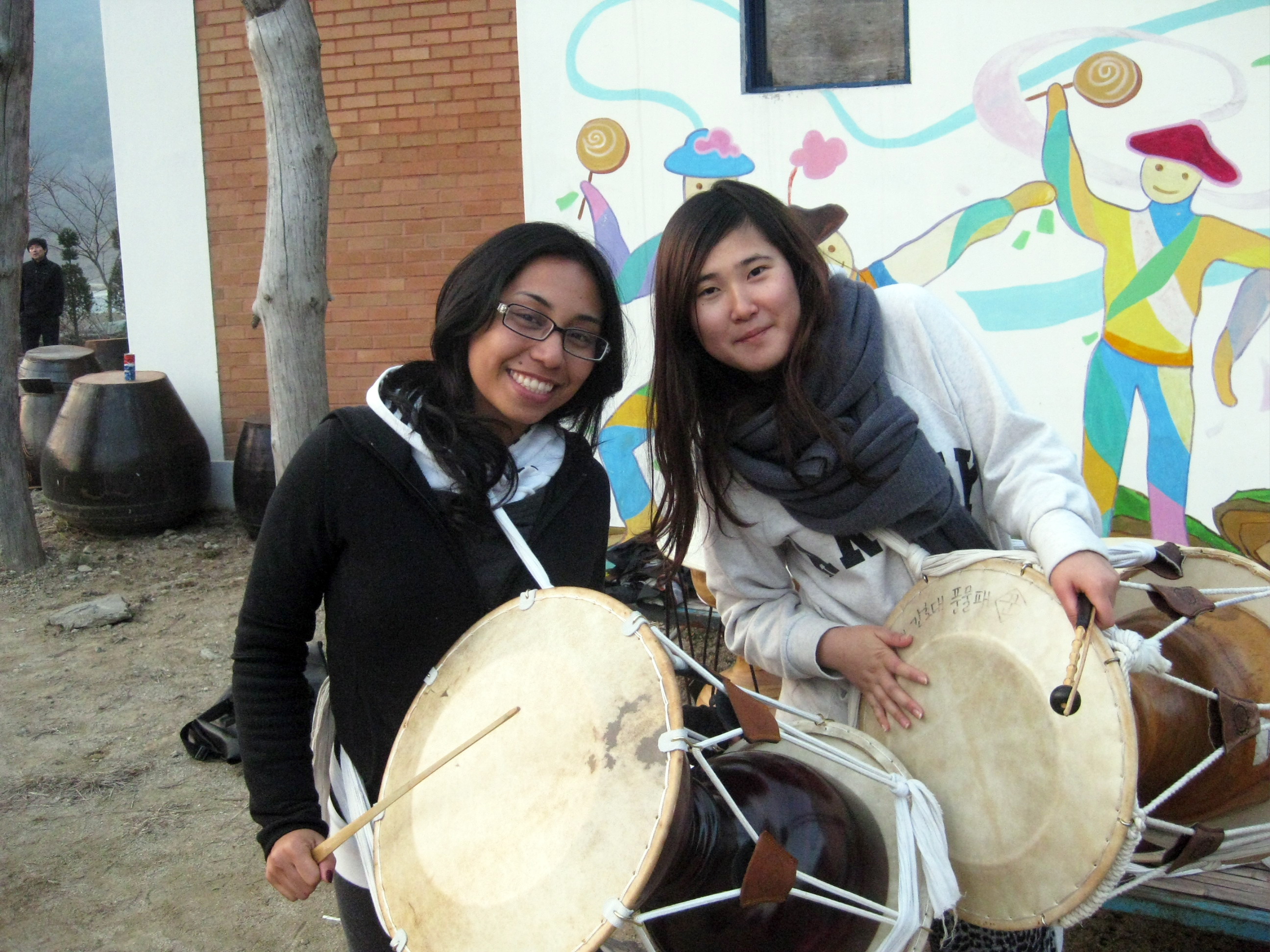Written by April Arrozal ETA’09-10
Dong, dong, kung dak kung…
Dong, dong, kung dak kung…
Even on such a cold day, I could feel the warmth and excitement from my fellow classmates wanting to learn more as we waited patiently for our teacher to arrive. For a week in January during my winter vacation, I had the opportunity to learn how to play janggu (Korean traditional hourglass drum) at Imsil Pilbong Nongak Village. Pilbong is a town located in Imshil county, Jeollabuk-do province. Famous for its skilled Korean traditional percussionists, the village was designated by the Korean government’s Cultural Heritage Administration as one of the nation’s “Intangible Cultural Properties.” Many Koreans know about this place and have often come here for a festival or, as we did, to learn traditional percussion.
On this day, the students arrived early and were eager to get started. When I first sat down, I watched closely as my classmates hit the janggu with the yeolchae (thin bamboo stick) in their right hand and the gungchae (bamboo stick with wooden mallet) in their left. A student in the middle of the classroom led the entire group. We all looked to her to follow the rhythm so we would know when to slow down or play faster. She led us to sound as one. We played this rhythm, which starts and ends a melody, until our teacher arrived and class officially began.
I came to Pilbong knowing only a few things about Korean traditional percussion, such as the names of each part of the instrument, the correct way to create different sounds, and some basic rhythms. I was the only foreigner at my camp, and all of the classes were taught in Korean. Prior to the camp, I had only played janggu for a total of five hours, so I did not have a lot experience. Upon arrival, my host dad, himself a highly respected Pilbong trustee, asked one of the university students to help me outside of class. Having this tutor was vital in my effort to bridge the language gap.

My classmates consisted of 28 high school boys from Jeonju, Jeollabuk-do province, as well as of students from universities all over Korea. The entire class was about 62 students including myself, but I was told that other groups could include as many as 100 students. When I asked my classmates how they heard about Pilbong, most cited the village’s reputable teachers. Most of these students had been playing for more than a year and, although many had never visited Pilbong before, were already highly talented players. This was one of the best things about going to Pilbong and learning janggu — being surrounded by students who had already learned and wanted to continue to learn about their culture while they were still young. In doing so, they ensure that Korea’s culture will continue to be passed down from one generation to the next.
I attended classes Monday through Friday, twice a day for at least three hours — one from 9 a.m. to 12 p.m. and the other from 2 p.m. to 6 p.m. Although classes were already long, I practiced during breaks and into the night, sometimes until 8 p.m., while the advanced students practiced until 10 p.m. On the last night of the camp, I had the opportunity to perform with my classmates around a campfire, wearing full traditional outfits. Since this was a very rare cultural experience for me, I couldn’t stop dancing and playing music despite the cold mud beneath my feet.
Going to this camp not only heightened my cultural understanding, but also provided insights into my own teaching and lesson planning process. As an ETA, I realized that what I was witnessing in the Pilbong classrooms was similar to what my own students experience on a daily basis at my school: waking up early, spending the entire day listening to lectures, asking few questions and taking only short breaks to eat. Even though I was excited to learn as a student at Pilbong, I was also exhausted and felt restless on some days. After returning to my school in Jeonju, I made sure to incorporate even more student involvement into my lesson plans. In addition, I learned to be more patient with my students when they said they were tired.

Probably the best part of my Pilbong experience was the gift of friendship. My new janggu-playing friends are caring university students who have continued to help improve my skills beyond that week. On one occasion, I visited Woosuk University to support my Pilbong classmates when they gave a janggu performance on campus. Afterward, they came to visit me in Jeonju once for coffee, and another time for my birthday dinner. We have already made plans for me to visit Woosuk University again, but this time, for a joint janggu performance.
One day in Pilbong, as I sat and watched my classmates, I closed my eyes and listened to the rhythm — dong, dong, kung dak kung. I heard the harmony between the men and women, the young and old, and I began to reflect on how this music represents so much for the Korean people. One of my reasons for applying for a Fulbright grant was to have opportunities such as these. With this in mind, I took a deep breath and picked up my yeolchae and gungchae, joined the rest of the group, and made dong, dong, kung dak kung come alive within me.
